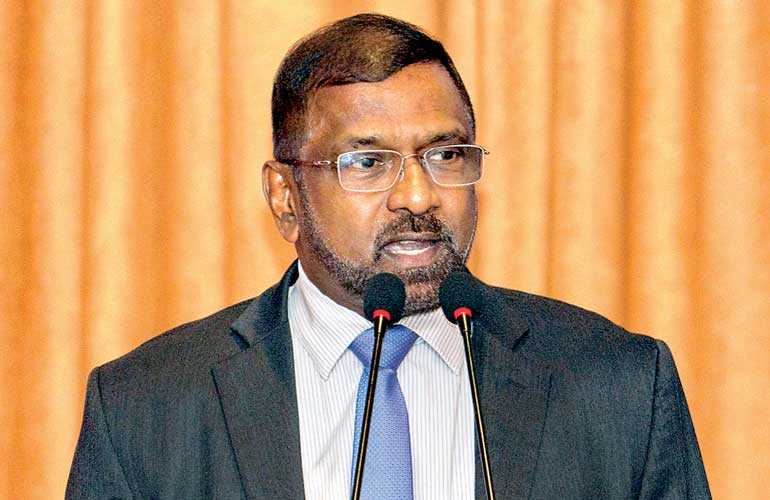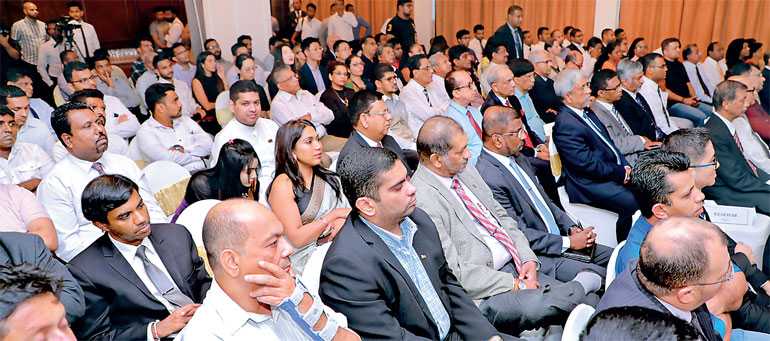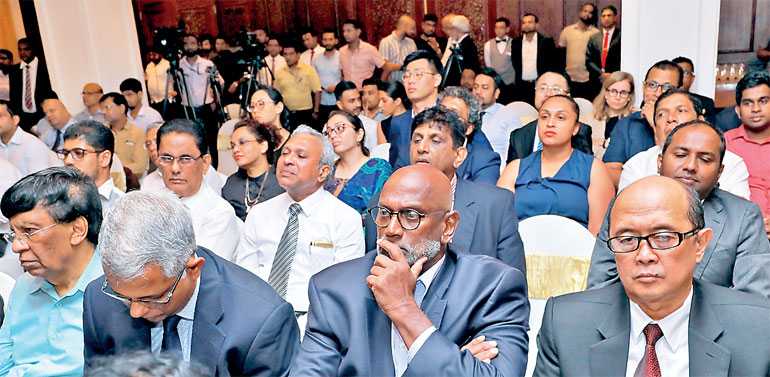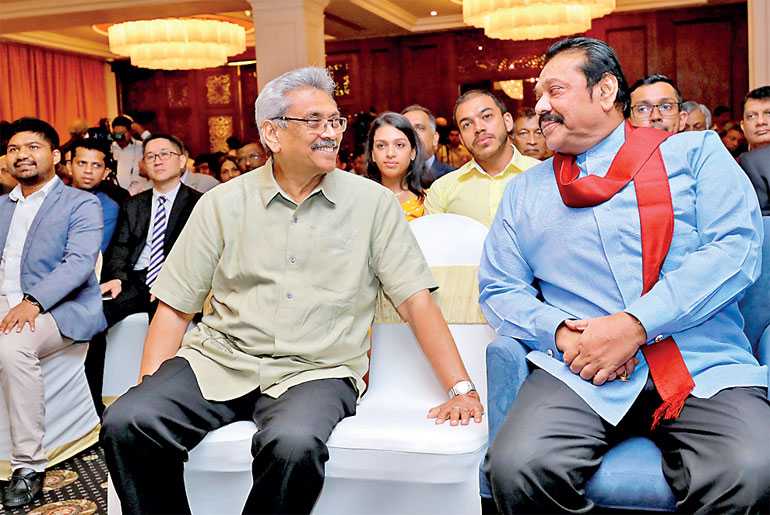Tuesday Apr 22, 2025
Tuesday Apr 22, 2025
Monday, 2 September 2019 00:00 - - {{hitsCtrl.values.hits}}

Good evening ladies and gentlemen, your excellencies, distinguished participants, I have a very difficult task to perform. That is to summarise three excellent speeches made by the esteemed and erudite panellists this evening.
At the outset, let me summarise the current geopolitical and strategic situation in the Indian Ocean. I would say that this is a region of; strategic competition, strategic convergence and of course strategic dilemma. Strategic competition by major powers against major powers, strategic convergence of some major powers against other major powers and strategic dilemma for economically and militarily less powerful states. Sri Lanka is caught up in this geopolitical and geo-strategic competition. It is taking place in front of our own eyes. It is not a fiction or imagination.
There is no doubt that a big game of geopolitical and strategic competition is taking place in the Indian Ocean. We see protectionism rather than globalisation; we hear about trade wars and cyber wars. The big game is on. I like to call this game with an acronym – RMB. This means Resources, Markets and Bases.
Let me now describe the aspect of resources. Indian Ocean is the energy super highway for the world, 72% of world energy is transported across the Indian Ocean. Furthermore, 50% of world containers and 35 percent of bulk cargo are transported across this ocean. Japan, South Korea and even Sri Lanka are net energy importers. Countries such as India, China and many other countries depend on oil and gas imports across the Indian Ocean. Although we talk about alternative energy resources, in the foreseeable future we will depend on fossil fuels. Therefore, world’s energy hub will continue to be the Persian Gulf and the Indian Ocean is the gateway. Admiral Sunil Lanba stated that: “International trade remains the prime mover of economics and development”.
If the Indian Ocean trade and energy flow is interrupted, the world economy will collapse. Indian Ocean is also a warm water ocean; Lot of Fish and marine ecosystems. Large number of rivers, tributaries, bring in sediments to this ocean for thousands of years. Hence, we can assume that beneath these sediments, there should be oil and gas and commercially exploitable quantities of sea bed minerals. We need to remember that resources can lead to geostrategic competition and even conflict.
Now I will focus on markets. We are aware that China is the world second largest and Japan is at the third palace and India at sixth. These countries and other rising economies such as South Africa, Indonesia and Singapore are either in the Indian Ocean or immediate neighbourhood.
The population of IOR is 2.5 billion, which is one-third of world population. Population of India is 1.34 billion – Indian middle class is growing, the fastest growing major economy in the world is India. We have great potential in the Indian Ocean. We need to produce more and trade more as emerging markets are here.
Now the third aspect, the bases. We remember that colonial powers dominated the Indian Ocean as they had control of land bases. They also controlled strategic islands. Bases does not mean only military bases, now it could be harbours or other strategic assets too. There is a competition to have bases in the Indian Ocean.
We have Indian Ocean littorals and residential powers. Dr. Ron Ying stated that China is an Indian Ocean country based on historical context and geographical proximity, specially the Western and South western parts of China. Similarly, many other powers claim that they are resident powers of the Indian Ocean. It could be based on control of islands and bases.
We have many strategic and connectivity Initiatives for Indo Pacific Region. The biggest initiative is the Chinese led Belt and Road Initiative (BRI) with a one trillion US dollar commitment and with the backing of the Asia Infrastructure Investment Bank (AIIB). Then we have the Asia Africa Growth Corridor (AAGC) by Japan and India. We also have Free and Open Indo-Pacific Strategy of Japan and USA’s Indo-Pacific Strategy. There is also a Quad by four pillar Countries; namely USA, Japan, Australia and India. India has its own strategic and port related initiatives such as Security And Growth for All in the Region (SAGAR) and Sagar Mala.
I like to ask the question, where is South Asian Centrality and initiative in the Indian Ocean? Dr Raja Mohan spoke about ASEAN centrality in the Indo-Pacific. All these strategies and initiatives are having stated objectives such as connecting people and infrastructure and economic development. Do these have any military or long-term strategic objectives to establish military foot print and influence? Through these strategies, initiatives and counter initiatives, we clearly see the strategic competition and convergences.
Ladies and gentlemen, the obvious reason for most of these strategies is the rise of China. We have an established super power (USA), we have an emerging super power (China). Let me state here based on historical experience, no power has risen quietly and no power has gone out quietly. Let me now focus to another aspect of the theme of this conference. That is the marine environment of the Indian Ocean. As much as 40% of world oceans are heavily impacted by human induced activities resulted in depleting fisheries and loss of coastal habitats. Plastic pollution is the number enemy number one of the ocean. Sri Lanka is named as one of the leading countries, which dump plastic to the ocean.
Global warming is real and taking place, Arctic Ice is melting and Northern sea route is becoming a possibility. Ocean temperatures are rising and salinity is increasing and hydrodynamics of the ocean are impacted such as tides and currents. Many countries will be vulnerable for sea-level rising. This is a hidden danger. We do not fully see or understand the danger. We are ocean blind in many ways.
There is a huge garbage patch discovered in 2010 in Southern Indian Ocean containing plastics and chemical sludge, invincible to the naked eye. There is also a 60,000 Sq km dead zone in the Bay of Bengal, discovered in 2016 by scientists from Denmark and India. Very little oxygen and nitrogen in this dead zone and no marine life. Bothe these garbage patch and dead zone are growing.
The Food and Agriculture Organization estimates that 40% of fishing taking place in the Indian Ocean is Illegal Unreported and Unregulated (IUU). Admiral Lanba highlighted the dangers of IUU fishing. If we allow these trends to continue there will not be fish or sea food for our future generations. Marine environmental aspects can have serious negative consequences on human security; habitats and food too.
Let me come back to the aspect of strategic dilemma. South Asia is the least integrated region in the world. Only less than 5% of our combined GDP is economically integrated. One of the main reasons is lack of infrastructure. World Bank Group released a report in 2018 stating that 50% of world infrastructure needs are in Asia.
The same report indicated that Asia need $ 460 billion from 2016-2030 to develop infrastructure. Where can this many come from? Can it be from traditional donors, self-financing, own banks or multi-lateral lending? The answer is no. It has to be FDI. But it is not coming. FDI to Sri Lanka is 1.2% of GDP in 2018. This is not good for a developing nation. We are going to miss Sustainable Development Goals by 2030.
We are going to miss the Industrial Revolution 4.0. How can we focus of artificial intelligence, machine learning, big data, clouds, 3D printing and autonomous platforms, when we do not get sufficient FDIs? This is the predicament of many smaller countries like Sri Lanka.
We are unable to make decisions based on economics. We have or we are compelled to undertake strategic balancing. It is a very difficult thing to do. This is the challenge we need to overcome.
There are many uncertainties and unpredictability. How do we translate this strategic dilemma to strategic opportunity? Dr. Ron Ying ask the question, whether the strategic location of Sri Lanka is a blessing or a curse? How do we capitalise the maritime centrality of Sri Lanka in the Indian Ocean for our prosperity? This is the challenge of this moment.
Professor Raja Mohan shared many experiences we can draw from ASEAN region. He explained how countries can benefit by working together to address common issues and concerns despite having differences. He emphasised the need for maritime safety and security for prospering maritime trade.
Sharmila Gunasingham quoted: “Small countries do not shape the world events, but the events shape us.” I am not disputing that statement. But I do believe that Sri Lanka by using its geostrategic location can influence to shape at least the Indian Ocean Region. Sri Lanka can play a key role in Indian Ocean trade and environment.
Ladies and gentlemen, there is no doubt that the Indian Ocean is the ocean of the future. Indian Ocean is too big for one power to dominate.
No single power can be the net security provider in the Indian Ocean. We need collaborative efforts for collective defence. What we need is inclusivity and not exclusivity. We need an international rule based maritime order. We need a more peaceful and stable and prosperous region. We need a peaceful complete Indian Ocean. Not only in a part of it as the Bay of Bengal and Western Indian Ocean are both important to the prosperity of us. There are many doable and ‘low hanging fruits’. We need not look only at grand plans or strategies.
We need wisdom for our leaders and the public. We need visionary leaders who understand how the world system work and the strategic value of Sri Lanka in the Indian Ocean, and to capitalise on that for the country. We need leaders who believe in Sri Lanka’s ability to dominate the Indian Ocean. We must not miss this opportunity.
Thank you very much.
(The writer, PhD, is Director of the Pathfinder Foundation.)



Discover Kapruka, the leading online shopping platform in Sri Lanka, where you can conveniently send Gifts and Flowers to your loved ones for any event including Valentine ’s Day. Explore a wide range of popular Shopping Categories on Kapruka, including Toys, Groceries, Electronics, Birthday Cakes, Fruits, Chocolates, Flower Bouquets, Clothing, Watches, Lingerie, Gift Sets and Jewellery. Also if you’re interested in selling with Kapruka, Partner Central by Kapruka is the best solution to start with. Moreover, through Kapruka Global Shop, you can also enjoy the convenience of purchasing products from renowned platforms like Amazon and eBay and have them delivered to Sri Lanka.
Discover Kapruka, the leading online shopping platform in Sri Lanka, where you can conveniently send Gifts and Flowers to your loved ones for any event including Valentine ’s Day. Explore a wide range of popular Shopping Categories on Kapruka, including Toys, Groceries, Electronics, Birthday Cakes, Fruits, Chocolates, Flower Bouquets, Clothing, Watches, Lingerie, Gift Sets and Jewellery. Also if you’re interested in selling with Kapruka, Partner Central by Kapruka is the best solution to start with. Moreover, through Kapruka Global Shop, you can also enjoy the convenience of purchasing products from renowned platforms like Amazon and eBay and have them delivered to Sri Lanka.